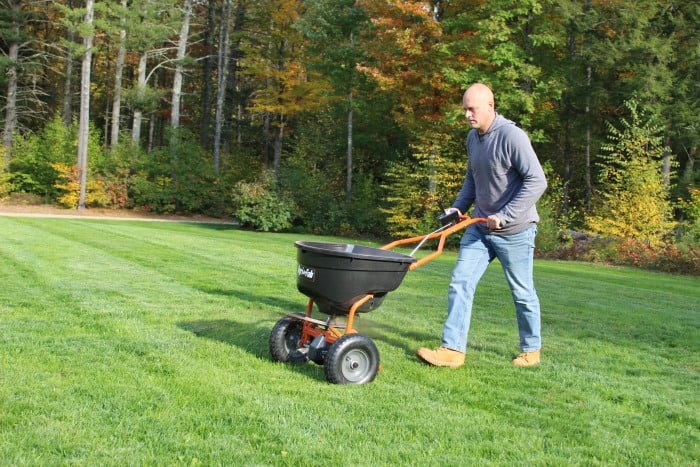The last fertilizer application of the season is an important one, but do you need to use a winterizer fertilizer? Here’s what you need to know about your last fertilizer application.
What Is Winterizer Fertilizer?
What is Winterizer Fertilizer and do you really need it? How is it different than other fertilizers, and when should you apply it? These are all common questions as we prepare our lawns for the end of the season.
The truth is ‘Winterizer’ is really just a marketing term the fertilizer companies came up with for the last fertilizer application of the season.
There’s really nothing special about that bag of fertilizer labeled ‘Winterizer’. It’s actually just fertilizer that is higher percentages of a specific macronutrient.
For cool season lawns the important macronutrient heading into winter is nitrogen (the first number on your fertilizer label). A little Potassium is good too (the third number).
For warm season lawns you want little to no nitrogen and mostly just potassium (the third number).
There’s no special compound or chemical other than what’s typically found in fertilizer.
When fertilizer companies market their fertilizer as a Winterizer, they’re simply acknowledging it’s a good fertilizer to apply during the end of the year because it contains the macronutrients you need to give your lawn depending on your location (north or south). But the truth is any bag of fertilizer containing the correct macronutrients will do. It does not have to be labeled Winterizer.
Understanding those three numbers on your bag of fertilizer (N-P-K) are important. But for now, the biggest takeaway should be that for cool season lawns you want mostly nitrogen (N) heading into winter. For warm season lawns you want potassium (K).
Since cool season and warm season lawns need to be treated differently during the winter, let’s break them down separately:
Cool Season Lawn- Last Fertilizer Treatment
What Does the Last Fertilizer Treatment Do?
If your timing is right, the last fertilizer treatment of the year shouldn’t do anything for your lawn until the following spring.
The idea is to apply your final fertilizer application after your last mow of the season. At this point the lawn should be done growing for the year. The lawn is not completely dormant though, since underneath the soil the roots remain active until they freeze. This is the time to fertilize!
In preparation for winter dormancy, your lawn will respond to the fertilizer treatment by taking in the nitrogen and storing it over the winter. It will use the stored nitrogen in early spring while coming out of dormancy. This is what gives you a nice head start in the spring.
It’s usually easy to spot the people who did this correctly when driving through a neighborhood in early spring.
What Fertilizer Is Best for Last Application for Cool Season Grass?
We’ve already established that you don’t necessarily need a fertilizer labeled as ‘Winterizer’, just a fertilizer that contains mostly nitrogen.
The great thing is you can shop around for deals. Since it’s the end of the season, big box stores usually have fertilizers on clearance. The only fertilizer that is actually still marked up are the ones labeled Winterizer. Save yourself some money.
Something like Scotts Turf Builder is sometimes on sale around the end of fall. The breakdown is 32-0-4. That means the bag contains 32% nitrogen. That’s a great choice for a last application. Any other synthetic fertilizer containing mostly nitrogen is fine to use.
Notice how I just recommended synthetic fertilizers for the last treatment. For most of the year I’m a big fan of slow release fertilizers containing organics. But for the last treatment, a quick release, water soluble nitrogen can be beneficial. In some areas, especially up north, the weather can get real cold, fast. You want to make sure the fertilizer has enough time to be absorbed before the ground freezes. Water soluble Synthetic fertilizers get absorbed quicker than most organic fertilizers.
Not to contradict myself, but if you prefer staying organic or sticking with a slow release nitrogen fertilizer, or perhaps you have some left over that you want to use up, then by all means use it for your last treatment. In most cases it will have plenty of time to be absorbed and what doesn’t get absorbed will likely overwinter and be available when the ground thaws in the spring.
Lastly, if sticking with a slow release fertilizer you can choose to apply a little earlier than you would a synthetic fertilizer to close out the season. This allows for the grass additional time to absorb the nitrogen.
How Much to Apply
Apply 1 pound of nitrogen per 1000 s/f for your last fertilizer application of the season. You could apply a little less, but don’t exceed a pound, especially with synthetic fertilizers since they are more susceptible to burn, even during the winter.
If you’re wondering how figure 1l/b of nitrogen per 1000 s/f check out my post on : How to fertilize your lawn. I explain how to figure application rates and how you can’t really trust spreader settings.
Warm Season Lawn- Last Fertilizer Treatment
What Does the Last Fertilizer Treatment Do for Warm Season Grass?
Winter lawn care for warm season lawns is very different than cool season lawns. Unlike cool season lawns, warm season lawns go dormant on top but the soil stays active. Soil temps usually remain warm enough so there is still activity going on in the root system of your lawn.
This is a period of high stress for warm season lawns. The last thing you want to do is add nitrogen to your stressed out lawn during this period. Conditions are not ideal for pushing blade growth, so don’t try and force it by using nitrogen. This will cause more stress.
Instead, what you want to do is apply a treatment of mostly potassium (K). This is the third number on a fertilizer label. Potassium helps lawns by maintaining turgor pressure in the cells of the lawn. This helps it during periods of cold, drought, or disease. All you need to know is that potassium helps lawns in times of stress. For warm season lawns winter is one of the most stressful times.
What Fertilizer Is Best for Last Application for Warm Season Grass?
When soil temps head down past 70 degrees heading into fall or winter (depending on location) your warm season grass will start slowing down. At this point you may only have a couple of mowing weeks left, if that. This is when you should apply your last round of fertilizer for the season, and it should be mostly potassium, and barely any nitrogen. That’s why I highly recommend Stress Blend 7-0-20 as the last fertilizer application of the season.
Also, with warm season lawns this is the time you want to apply a final round of pre emergent herbicide to block annual weeds that can emerge all fall and throughout the winter months as your warm season grass enters dormancy along the surface.
I recommend applying Dithiopyr 0-0-7 or Prodiamine 0-0-7 for your pre emergent at this time. Notice how both those products contain 7% potassium which is going to give you additional potassium on top of the Stress Blend 7-0-20. This combo approach will help keep you protected from weeds throughout the winter and will also give you the much needed potassium for the winter months. Check out my Lawn Program for Warm Season Grass to see what you should be putting down all season.
Keep Irrigating
With warm season lawns continue to irrigate throughout the winter as needed. It doesn’t have to be as often as during the summer months but don’t forget your lawns root system is still active. It seems unnatural to irrigate a lawn that looks dormant on top but it’s important to remember the roots still need water. Remember, your warm season lawn is stressed during the winter months, irrigating will help reduce stress.
Check Out These Posts Next
Lawn Care Program for Warm Season Grass (2)
Lawn Care Program for Cool Season Grass
Top Dressing Lawn: Benefits and Advice
Lime Your Lawn: A Complete Guide
Lawn Dethatching: Everything You Need to Know
Kill Weeds Without Killing Grass
Follow Me
Join my free email list!
Plus, follow me on Facebook, Instagram, and Pinterest.


I am new to this and learning fast. Thanks for your article on winterizer fertilizer as I am looking not on fancy expensive trade name products but at the generic equivalents.
Could you forward me any articles you have on Lawn Care please?
I failed to get the 12 point plan on lawn care you tried to send me..
Hi Francis. Glad to hear you’re learning fast. I have all articles on my blog. If you click on the Lawncare category you’ll see a bunch of different articles ranging from soil temps to lawn care programs and weed control etc. There’s not that many so I recommend reading them all at some point. Also check your spam folder because the email for the opt in might have landed there. Good luck and let me know if you have any questions!
Thanks a million Mark. Love your article on Winterizer..Your work is a breath of fresh air, even over here In Ireland.
Excellent explanation of so called Winterizer Fertilizers.
Thanks Dave!
Excellent article. Cool season grass here in MD and generally get all of my nitrogen down between September and December with several heavy applications of Scotts WinterGuard Turf Builder.
Nice, that’s a good strategy!
Your information will help me a lot on winter fertilizing.
Hi Mark,
The link you provided for Scott’s fertilizer directs me to a fertilizer that says it’s for Southern lawns. But I’m up north near Chicago. Can I still use it as my final application of the year?
Or do you recommend something else for cool season grass?
Thanks.
I like it, nice one
Thanks Jimmy!